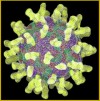The common cold is also known as rhinovirus. It is defined as an acute respiratory tract infection marked by mild coryzal symptoms (cold reaching the head), rhinorrhea(dripping of the nose), nasal obstruction (blocked nose), and sneezing.
Definition:
Medically it is known as influenza
 virus infection. This disease is one of the most common infections and is among the most contagious airborne diseases. It is marked by an acute febrile illness (fever) and causes various systemic symptoms ranging from mild fatigue to respiratory failure. It severe cases, it can also prove to be fatal.Clinically there are two types of flu, called as influenza A, B or C infection.
virus infection. This disease is one of the most common infections and is among the most contagious airborne diseases. It is marked by an acute febrile illness (fever) and causes various systemic symptoms ranging from mild fatigue to respiratory failure. It severe cases, it can also prove to be fatal.Clinically there are two types of flu, called as influenza A, B or C infection.

Microorganism
There are a number of agents that can cause common cold though a majority of them (66-75%) of them are caused by 200 antigenically distinct viruses. Among them, the most common are rhinoviruses (25-80%), coronaviruses (10-20%), Influenza virus (10-15%), and adenovirus (5%).

Microorganism-
these can be caused due to various viruses, most common being adenoviruses, enteroviruses and paramyxoviruses.
 Mode of infection-
Mode of infection-
This is a communicative disease that spreads through droplet infection and can also occur due to change in weather. The most common route is the nasal and oral cavity
 Mode of infection-
Mode of infection-
this is also a communicative disease. However, this spreads faster than common cold.
-
Frequency
– In the United States, most people have an average frequency of 1 episode in 1-2 years. Rhinoviruses cause up to 80% of this disease in the autumn months
-
Frequency-
Flu usually takes the form of an epidemic in winter months in America. The severity depends on the pathogen involved. Within a year, millions of people can suffer from this infection.
 Mortality-
Mortality-
Although common cold is not fatal, it accounts for 30-50 % of time lost by adults and 60- 80 % of time lost by children.
 Mortality ‘
Mortality ‘
flu can prove to be fatal and in America alone, it accounts for more than 20,000 deaths annually.
 Symptoms-
Symptoms-
the incubation period for this disease is 12-72 hours. Some of the most common symptoms are-
- Nasal discharge which is yellow, green of white
- Nasal congestion
- Frequent sneezing
- Severe headache
- Facial and ear pressure
- Loss of smell
- Loss of taste
- Chest auscultation reveals ronchi (scrapping sound resembling sandpaper rub)
These symptoms usually last for 7 ‘ 11 days though 25 % of the patients may suffer from it for more than 2 weeks. In case of patients suffering from asthma and chronic pulmonary disease, the symptoms can get aggravated.
 Symptoms
Symptoms
‘ The symptoms of flu appear from mild to severe. Severe patients appear ill with weakness while the mild ones show general symptoms. Some of the most common symptoms are:
- Fever- it can range from 100-104??F. As the person ages, the fever becomes more severe.
- Tachycardia- The heart rate increases due to hypoxia, fever or both.
- Throat infection- this can make talking and swallowing difficult.
- Reddening of the eye with watery discharge.
- Unlike common cold, patients usually do not have nasal discharge.
- Drug cough.


